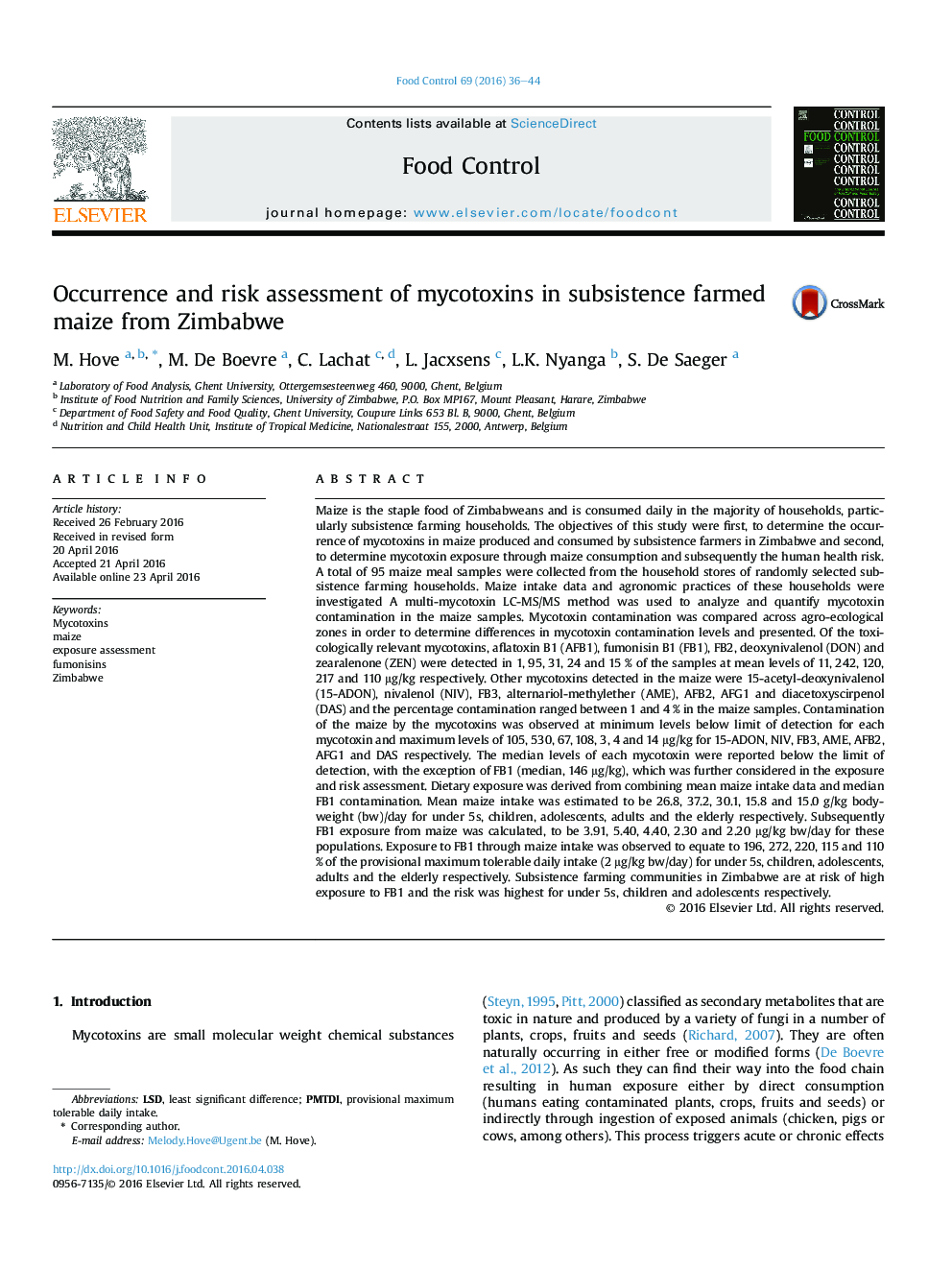| کد مقاله | کد نشریه | سال انتشار | مقاله انگلیسی | نسخه تمام متن |
|---|---|---|---|---|
| 6390005 | 1628393 | 2016 | 9 صفحه PDF | دانلود رایگان |
عنوان انگلیسی مقاله ISI
Occurrence and risk assessment of mycotoxins in subsistence farmed maize from Zimbabwe
ترجمه فارسی عنوان
پدیدار و ارزیابی ریسک مایکوتوکسین ها در ذرت مزرعه ای از زیمبابوه
دانلود مقاله + سفارش ترجمه
دانلود مقاله ISI انگلیسی
رایگان برای ایرانیان
کلمات کلیدی
موضوعات مرتبط
علوم زیستی و بیوفناوری
علوم کشاورزی و بیولوژیک
دانش تغذیه
چکیده انگلیسی
Maize is the staple food of Zimbabweans and is consumed daily in the majority of households, particularly subsistence farming households. The objectives of this study were first, to determine the occurrence of mycotoxins in maize produced and consumed by subsistence farmers in Zimbabwe and second, to determine mycotoxin exposure through maize consumption and subsequently the human health risk. A total of 95 maize meal samples were collected from the household stores of randomly selected subsistence farming households. Maize intake data and agronomic practices of these households were investigated A multi-mycotoxin LC-MS/MS method was used to analyze and quantify mycotoxin contamination in the maize samples. Mycotoxin contamination was compared across agro-ecological zones in order to determine differences in mycotoxin contamination levels and presented. Of the toxicologically relevant mycotoxins, aflatoxin B1 (AFB1), fumonisin B1 (FB1), FB2, deoxynivalenol (DON) and zearalenone (ZEN) were detected in 1, 95, 31, 24 and 15 % of the samples at mean levels of 11, 242, 120, 217 and 110 μg/kg respectively. Other mycotoxins detected in the maize were 15-acetyl-deoxynivalenol (15-ADON), nivalenol (NIV), FB3, alternariol-methylether (AME), AFB2, AFG1 and diacetoxyscirpenol (DAS) and the percentage contamination ranged between 1 and 4 % in the maize samples. Contamination of the maize by the mycotoxins was observed at minimum levels below limit of detection for each mycotoxin and maximum levels of 105, 530, 67, 108, 3, 4 and 14 μg/kg for 15-ADON, NIV, FB3, AME, AFB2, AFG1 and DAS respectively. The median levels of each mycotoxin were reported below the limit of detection, with the exception of FB1 (median, 146 μg/kg), which was further considered in the exposure and risk assessment. Dietary exposure was derived from combining mean maize intake data and median FB1 contamination. Mean maize intake was estimated to be 26.8, 37.2, 30.1, 15.8 and 15.0 g/kg bodyweight (bw)/day for under 5s, children, adolescents, adults and the elderly respectively. Subsequently FB1 exposure from maize was calculated, to be 3.91, 5.40, 4.40, 2.30 and 2.20 μg/kg bw/day for these populations. Exposure to FB1 through maize intake was observed to equate to 196, 272, 220, 115 and 110 % of the provisional maximum tolerable daily intake (2 μg/kg bw/day) for under 5s, children, adolescents, adults and the elderly respectively. Subsistence farming communities in Zimbabwe are at risk of high exposure to FB1 and the risk was highest for under 5s, children and adolescents respectively.
ناشر
Database: Elsevier - ScienceDirect (ساینس دایرکت)
Journal: Food Control - Volume 69, November 2016, Pages 36-44
Journal: Food Control - Volume 69, November 2016, Pages 36-44
نویسندگان
M. Hove, M. De Boevre, C. Lachat, L. Jacxsens, L.K. Nyanga, S. De Saeger,
